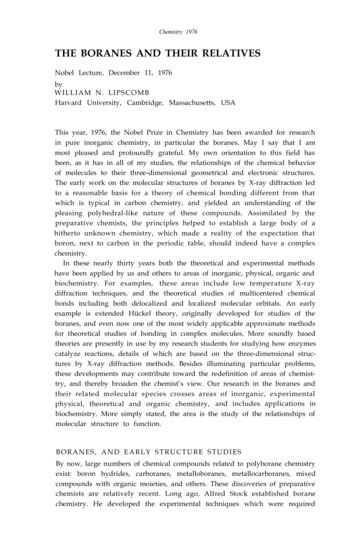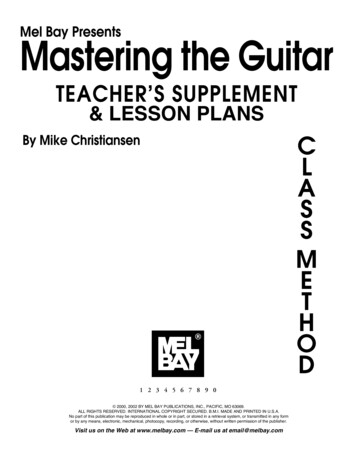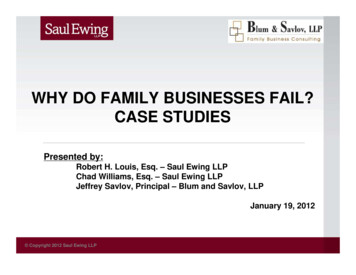
Transcription
Chemistry 1976THE BORANES AND THEIR RELATIVESNobel Lecture, December 11, 1976byWILLIAM N. LIPSCOMBHarvard University, Cambridge, Massachusetts, USAThis year, 1976, the Nobel Prize in Chemistry has been awarded for researchin pure inorganic chemistry, in particular the boranes. May I say that I ammost pleased and profoundly grateful. My own orientation to this field hasbeen, as it has in all of my studies, the relationships of the chemical behaviorof molecules to their three-dimensional geometrical and electronic structures.The early work on the molecular structures of boranes by X-ray diffraction ledto a reasonable basis for a theory of chemical bonding different from thatwhich is typical in carbon chemistry, and yielded an understanding of thepleasing polyhedral-like nature of these compounds. Assimilated by thepreparative chemists, the principles helped to establish a large body of ahitherto unknown chemistry, which made a reality of the expectation thatboron, next to carbon in the periodic table, should indeed have a complexchemistry.In these nearly thirty years both the theoretical and experimental methodshave been applied by us and others to areas of inorganic, physical, organic andbiochemistry. For examples, these areas include low temperature X-raydiffraction techniques, and the theoretical studies of multicentered chemicalbonds including both delocalized and localized molecular orbitals. An earlyexample is extended Hückel theory, originally developed for studies of theboranes, and even now one of the most widely applicable approximate methodsfor theoretical studies of bonding in complex molecules. More soundly basedtheories are presently in use by my research students for studying how enzymescatalyze reactions, details of which are based on the three-dimensional structures by X-ray diffraction methods. Besides illuminating particular problems,these developments may contribute toward the redefinition of areas of chemisttry, and thereby broaden the chemist’s view. Our research in the boranes andtheir related molecular species crosses areas of inorganic, experimentalphysical, theoretical and organic chemistry, and includes applications inbiochemistry. More simply stated, the area is the study of the relationships ofmolecular structure to function.BORANES, AND EARLY STRUCTURE STUDIESBy now, large numbers of chemical compounds related to polyborane chemistryexist: boron hydrides, carboranes, metalloboranes, metallocarboranes, mixedcompounds with organic moieties, and others. These discoveries of preparativechemists are relatively recent. Long ago, Alfred Stock established boranechemistry. He developed the experimental techniques which were required
W.N. Lipscomb225for the preparation of the volatile and potentially explosive compounds, B2H6,B4H10, B5H9, B5H11 and B6H10, and the relatively stable white crystalline B10H14. Thiswork, beautifully summarized in his Baker Lectures,1 was celebrated in the ThirdInternational Meeting on Boron Chemistry this past July in Munich, 100 years afterhis birth. Sidgwick2 wrote, “All statements about the hydrides of boron earlier than1912, when Stock began to work on them, are untrue.”Aside from the classification as either an N 4 or an N 6 series, no simple basisfor these unusual formulas was foreseen before their structures were established. AB6 octahedron (Fig. 1) was known in certain crystalline borides, and the B12icosahedron (Fig. 2) was found in boron carbide, but no one realized that asystematic description of the boron arrangements in these hydrides might be basedon fragments of these polyhedra. Most electron diffraction work before 1940supported more open structures, which Pauling3 described in terms of resonatingone-electron bonds. In 1940-1941 Stitt4 produced infrared and thermodynamicevidence for the bridge structure of B2H6 (Fig. 3). More general realization of thecorrectness of this structure followed the theoretical studies,5-8 and especially theinfrared work of Price.9 The three-center bridge BHB bond was clearly formulatedby Longuet-Higgins.8
226Chemistry 1976The first of the higher hydrides to be structurally characterized was B 10H 11(Fig. 4). Kasper, Lucht and Harker10 showed that the boron arrangement wasa fragment of a B12 icosahedron in which there are four bridge BHB bonds inthe open face. Next was B5H 9,11 , 12 (Fig. 5), a fragment of the B6, octahedron,13,14(Fig. 6), a B4 unit from these polyhedra. Both of theseand then B 4H 10structures were established by X-ray diffraction in our laboratory, and byelectron diffraction at the California Institute of Technology. Our X-ray16diffraction results on B 5H 1115 (Fig. 7) and tetrahedral B 4Cl 4 then set the stagefor the beginning of the theory of bonding. The B 6H 10 structure, 17,18 (Fig. 8)completing the compounds found by Stock, was to be one of our later X-raydiffraction studies, which were to include many other boranes and relatedmolecules.It was actually in 1946 that I decided to enter this area of inorganic chemistry. At that time, no reliable methods were generally available for accumulation of large amounts of X-ray diffraction data at low temperatures. Ourmethods 19 paralleled those in Fankuchen’s laboratory20 at the then PolytechnicInstitute of Brooklyn, but were quite independent. Because of the specialdifficulties of working with the volatile boranes, I chose among other topics,a series of X-ray diffraction studies of single crystals grown at low temperaturesfrom low melting liquids for which putative residual entropy problems
W. N. LipscombFig. 7. B5 H 11 .227Fig. 8. B6 H 10 .existed: N 2O 2, CH 3N H2, CH 3OH, N 2H 4, COCl 2 a n d H2O 2. The subsequentlow temperature studies of single crystals of these volatile and unstable boraneswere not without hazards. Vacuum line techniques were learned as we neededthem. Fortunately, no serious injuries were incurred as a result of severalexplosions resulting from cracks in these vacuum systems. I was relieved, onone occasion, when I had taken Russell Grimes to a hospital in Cambridgeafter one of these explosions to hear the doctor tell me, “Louis Fieser sends memuch more interesting cases than you do.” I still have in my office the air gunwhich I, or my young son, used on a number of occasions to destroy a crackedvacuum system from a safe distance. We also had chemical surprises, forexample, when we found a presumed B 8 hydride to be B 9H 15 .21 Our onlychemical analysis of this compound was the count of the numbers of boronand hydrogen atoms in the electron density map, which was calculated inthose days from rough visual estimates of intensities of diffraction maxima onfilms.THREE-CENTER BONDS AMONG BORON ATOMSAt the fortunate time in 1953 of W. H. Eberhardt’s sabbatical, he, Crawfordand I examined 22 the open boron hydrides B 2H 6, B4H 10, B5H 9, B5H 11 and B 10H 14from the viewpoint of three-center bonds; and we studied B 5H 9, the unknown-2polyhedral molecule B 4H 4, the then hypothetical ions B 6H 6 (Fig. 1) andB 12H 12-2 (Fig. 2) from the viewpoint of molecular orbitals. Longuet-Higgins 23also, independently, formed an early molecular orbital description almost likeours. One of the simple consequences of these studies was that electron deficientmolecules, defined as having more valence orbitals than electrons, are notreally electron deficient. I mean by this non-sequitur that the three-centertwo-electron bonds make possible a simple description of these molecules andions as filled orbital species. Filled molecular orbitals were later extended toclosed polyhedral compounds BnH n, for all values of n from 5 to 24, all of whichhave a formal charge of -2, even though hypothetical B 4H 4 is neutral. Infact, all of the experimentally known ions, for 6n 12, do have -2 charge.
228Chemistry 1976in addition to B 6 H 6 -2 (Fig. 1) and B 1 2 H 1 2 -2 (Fig. 2), those polyhedra for10 are shown in Fig. 9. The isoelectronic series C 2B n-2 H n is known5 nfor 5n12.Equations for the atom, orbital and electron balance were formulated inour paper of 1954, allowing prediction of many new chemical species. Onesimple form of these rules is exemplified for a neutral hydride formula B PH p qin which each boron atom has at least one terminal hydrogen atom. Definethe number of BHB bridges as s, the number of three-center BBB bonds as t,the number of two-center BB bonds as y and the number of extra terminalhydrogens on each BH unit as x. ThenThe first equation is the hydrogen balance. The second comes from the factthat each of the p boron atoms supplies four orbitals and only three electrons,and the extra orbital is utilized in one of the two types of three-center bond.Finally, if each BH unit is recognized as contributing a pair of electrons, thesep pairs are used in BBB or BB bonds, or in half of the pairs required for theextra hydrogens, s and x. These rules, and the accompanying valence structures, are especially helpful in describing those polyboron compounds whichare open, but they are also useful for closed polyhedral molecules and ions.Fig. 9. Structures for the boron and carbon arrangements in some of the polyhedral molecules C 2 B n - 2 H n , which are known for12. The isoelectronic anions are known for12.
229W. N. LipscombFig. 11. Bonds in B2 H 6 , accordingto three-center bond theory.Fig. 12. Bonds in B4 H 10 .Fig. 13. Bonds in B5 H 11 .Fig. 14. Bonds in B6 H 10 .There are two kinds of three-center bonds among three boron atoms (Fig.10). The central three-center bond involves positive overlap among hybridorbitals from each of three boron atoms, while the open three-center bondinvolves, on the central atom, a π orbital which overlaps in a bonding mannerwith an orbital from each of the adjacent boron atoms. The less compactB 2 H 6 , B4 H 1 0 , B5 H 1 1 and B 6H 10 structures (Figs. 11-14) are well described
230Chemistry 1976with the use of these three-center bonds, omitting open three-center BBBbonds for the moment. However, B5H 9 (Fig. 15) requires a resonance hybridof four valence structures, related by the four-fold symmetry; and B 10H 14(Fig. 16) requires a resonance hybrid of 24 valence structures.Fig. 15. One of four resonance structures for B 5 H 9 . Theother three are obtained by reorientation of the framework bonds by 90 about the molecular four-fold axis.Three-center bond theory was further developed in the following 22 years. 24I realized that the valence rules implied the existence of a large body of boronchemistry, and then ventured predictions, some of which were actually verifiedexperimentally. Dickerson 25 and I formalized my intuitive approach into atheory of connectivity of various bonding patterns within the three-centerdescription. Also, geometrical constraints were introduced in order to avoidovercrowding of hydrogen atoms and to preserve known bonding angles aboutboron atoms among the boranes.26 More recently, Epstein27 and I reformulatedthe topology using central three-center BBB bonds, to the exclusion of openthree-center BBB bonds. The recent work on localized molecular orbitals whichhas led to the restriction of open three-center bonds, so far, to BCB bonds isexemplified in a later part of this manuscript.MOLECULAR ORBITAL STUDIES OF BORANESMolecular orbitals are more appropriate for describing the valence structuresof the polyhedral molecules and ions, and the more compact polyhedralfragments. Two simple examples will suffice. In B5H 9 there are three pairs ofelectrons in the boron framework, which has four-fold symmetry. The bondingis beautifully described without resonance, by a simple σ and π set of molecularorbitals 22, 24, 28 (Fig. 17). These orbitals are similar to the bonding orbitals,for example, between planar four-fold cyclobutadiene (C 4H 4) and a CH placed along the four-fold axis to give the carbonium ion C 5H 5 .
W. N. Lipscomb231A similar σ, π situation occurs 28 if a BH unit is removed from icosahedralB 1 2H 1 2-2 l e a v i n g B1 1H 1 1- 2 having five atomic orbitals containing four electrons(Fig. 18). This set of five orbitals gives σ, π molecular orbitals which can bondto a similar set of σ, π orbitals from another atom or group of atoms supplyingtwo more electrons. I suggested, conceptually, adding H3 to predict B11H 14-,for example. Although recognizing the similarity of this set of orbitals to thosein C5H 5, which was known to form ferrocene Fe(C5H 5) 2, I did not then go2quite so far as to suggest bonding of this B 1 1H 1 1 - fragment to a transition metal.Later, Hawthorne did so, using these ideas as a starting point, and therebycreated the large family of metalloboranes and metallocarboranes 29 (Fig. 19).In the early 1960’s, when large scale computing facilities became availableto us, Roald Hoffmann and Lawrence Lohr independently programmed theFig. 18. Five atomic orbitals, containing fourelectrons remain when a neutral BH unit isremoved from the apex of B 1 2 H 1 2 - 2 , or C2 B 1 0 H 1 2 .These five atomic orbitals form aπ (bonding) and δ (antibonding) set of fivemolecular orbitals, like those in the π electronsystem of C 5 H 5 - .Fig. 19. The structure of (B9 C 2 H 11 )Fe(C 5 H 5 ), a metallocarborane derivative.
232Chemistry 1976extended Hückel method in my research group. Its first application was toboron chemistry, 30 where, particularly in the carboranes (compounds of boron,carbon and hydrogen), the charge distributions predicted sites of electrophilicand nucleophilic substitution. One of the rather simple rules which emergedwas that nucleophilic attack occurs in a polyhedral carborane at a boron atomclosest to carbon, while electrophilic attack was preferred at a boron furthestremoved from carbon. Experimental studies of boranes and carboranes inwhich one or more hydrogens had been replaced by a halogen or by an aminegroup confirmed these predictions. The extended Hückel method became fora time the most widely used program for the study of molecular theory andreactions in complex or
This year, 1976, the Nobel Prize in Chemistry has been awarded for research in pure inorganic chemistry, in particular the boranes. May I say that I am most pleased and profoundly grateful. My own orientation to this field has been, as it has in all of my studies, the relationships of the chemical behavior of molecules to their three-dimensional geometrical and electronic structures. The early .










